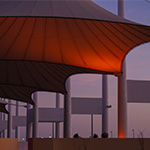The Diriyah Biennale Foundation announces And all that is in between as the title for the second edition of the Islamic Arts Biennale. The Biennale is set to open from January 25 until May 25, 2025 in Jeddah, a city that has represented a meeting point of cultures for centuries, at the Western Hajj Terminal of King Abdulaziz International Airport, a site that echoes with memory and emotion for millions of Muslim pilgrims embarking on their sacred journeys for Hajj and Umrah every year. By juxtaposing historical objects from Islamic cultures with contemporary art, the Biennale will explore how faith is experienced, expressed, and celebrated through feeling, thinking, and making.
Led by Artistic Directors Julian Raby, Amin Jaffer in his ongoing role as Director of The Al Thani Collection, and Abdul Rahman Azzam alongside Saudi artist Muhannad Shono as Curator of Contemporary Art, the Biennale will offer unique insights into the ways cultures endure in the context of the transformations taking place today in Saudi Arabia with a global frame of reference. The exhibition presents a dialogue between historic and contemporary works within the galleries and in outdoor spaces. The Biennale’s location at the Western Hajj Terminal strengthens its connection to Islamic heritage and faith.
And all that is in between is part of a verse that appears several times in the Noble Quran: “And God created the Heavens and the Earth and all that is in between.” It describes the absolute and all-encompassing majesty of God’s creation as perceived and experienced by humankind. Across five exhibition halls and outdoor spaces, and with more than 500 objects and contemporary artworks on view, the 2025 Islamic Arts Biennale will explore how we endeavor to comprehend the wonder of what the divine has brought into being.
H. H. Prince Badr Bin Abdullah Bin Farhan Al Saud, Minister of Culture, Kingdom of Saudi Arabia, Chairman of the Board of Trustees of the Diriyah Biennale Foundation, highlighted the transformative power of the arts in building a vibrant, thriving society, adding that through its impactful initiatives, the Diriyah Biennale Foundation remains dedicated to nurturing creative expression, arts and culture, and to enriching the global artistic landscape.
Prince Badr added: “Building on the remarkable success of the inaugural edition, the second edition of the Islamic Arts Biennale comes with greater ambition, expanded partnerships and a diverse selection of artistic and cultural institutions, patrons, as well as artists from Saudi Arabia and countries that have rich Islamic culture and traditions.”
Prince Badr expressed his hopes that the Islamic Arts Biennale will lead to a deeper understanding around the significant influence that the Islamic arts have had globally since the rise of Islam until the present day, adding that it will continue to be a trusted platform for the arts of Islamic civilization, both past and present, paving the way for future practices and fresh discourse for generations to come.
Aya Al-Bakree, CEO of the Diriyah Biennale Foundation: “The arts of Islamic civilization, both contemporary and historic and that have been made in or inspired by Islamic communities around the world, have influenced cultural discourse for centuries until today. With an unwavering purpose to craft perspectives, we are proud to announce the growth of the Islamic Arts Biennale in its second edition, evident through its expert curatorial leadership, and in the participation of world-leading institutions and artists coming together as part of an outstanding program that will cement the Biennale as a global platform for cultural exchange and a reference point for new research into the field.”
In its second edition, the Biennale presents significantly more works and welcomes a larger number of participating institutions. With this expansion, the Biennale affirms its position as the world’s central platform for Islamic arts. The exhibition will bring together loans from the world’s leading institutions of Islamic arts, from Tunis to Tashkent, and from Timbuktu to Yogyakarta. The participation of this global network of institutions offers a broad perspective on Islamic arts, past and present, and opens new channels for dialogue and collaboration. Treasured historical artifacts, religious objects, and works of art have been loaned from major institutions including the Louvre Museum (Paris) and the Victoria and Albert Museum (London), as well as collections devoted specifically to Islamic arts and cultures, such as the Ahmed Baba Institute of Higher Learning and Islamic Research (Timbuktu), the Museum of Islamic Art (Doha), and the Manuscript Institution of Türkiye (Istanbul). The Biennale brings together leading institutions from across Saudi Arabia, including the King Abdulaziz Center for World Culture (Ithra) (Dhahran), the King Abdulaziz Complex for Endowment Libraries (Madinah), and the King Fahad National Library (Riyadh), and also offers visitors a chance to see objects and works of art that come from the holy sites of Makkah and Madinah.
The Biennale presents new commissions from over 20 artists from Saudi Arabia, the wider Gulf region, and beyond, including Nour Jaouda, Charwei Tsai, and Fatma Abdulhadi. These commissions demonstrate the Diriyah Biennale Foundation’s work to offer a global stage for Saudi artists, and to bring artists from around the world to Saudi Arabia so that local audiences can encounter compelling practices and diverse perspectives in contemporary art.
The Islamic Arts Biennale will consist of seven unique components (AlBidaya, AlMadar, AlMuqtani, AlMathala, Makkah al-Mukarramah, Al-Madinah al-Munawwarah, and AlMusalla) spread out through different galleries and outdoor spaces, across 100,000 square meters of dedicated exhibition space.
Press release from the Islamic Arts Biennale
Image: The 2023 Islamic Arts Biennale at the Western Hajj Terminal of King Abdulaziz InternationalAirport. Image courtesy of the Diriyah Biennale Foundation



